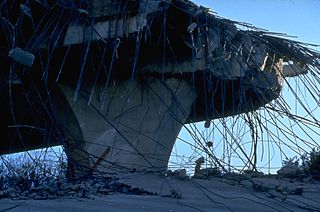
The 1994 Northridge earthquake was a moment magnitude 6.7, blind thrust earthquake that occurred on January 17, 1994, at 4:30:55 a.m. PST in the San Fernando Valley region of the City of Los Angeles. The quake had a duration of approximately 10–20 seconds, and its peak ground acceleration of 1.82 g was the highest ever instrumentally recorded in an urban area in North America. Shaking was felt as far away as San Diego, Turlock, Las Vegas, Richfield, and Ensenada. The peak ground velocity at the Rinaldi Receiving Station was 183 cm/s, the fastest ever recorded.
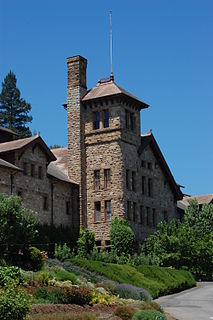
The Culinary Institute of America at Greystone is a branch campus of the private culinary college the Culinary Institute of America. The Greystone campus, located on State Route 29/128 in St. Helena, California, offers associate degrees and two certificate programs in culinary arts and baking and pastry arts. The CIA at Greystone and the Culinary Institute of America at Copia make up the school's California branch.

The 1933 Long Beach earthquake took place on March 10 at south of downtown Los Angeles. The epicenter was offshore, southeast of Long Beach, California, on the Newport–Inglewood Fault. The earthquake had a magnitude estimated at 6.4 , and a maximum Mercalli intensity of VIII (Severe). Damage to buildings was widespread throughout Southern California. It resulted in 115 to 120 fatalities and an estimated forty million dollars' worth of property damage, equivalent to $837 million in 2021. The majority of the fatalities resulted from people running out of buildings exposing themselves to the falling debris.

The Napa Valley Opera House is a theatre in Napa, California, it opened on February 13, 1880 with a production of Gilbert and Sullivan's HMS Pinafore.

Trefethen Family Vineyards is a winery in Napa Valley. It was established in 1968.

Architectural Resources Group is a firm that was founded in 1980 by Bruce Judd and Steve Farneth in San Francisco, CA. It began by providing professional services in the fields of architecture and urban planning with particular expertise in the area of historic preservation. In 2000, David Wessel, a Principal of ARG, founded a separate conservation-contracting division, ARG Conservation Services which operates under the same roof as ARG. By 2005, the firm had expanded to a full-service architecture firm with 50+ employees. ARG also opened offices in Pasadena serving Southern California, and Portland, Oregon, serving the Pacific Northwest.

Pasadena City Hall, completed in 1927, serves as the central location for city government in the City of Pasadena, California and is a significant architectural example of the City Beautiful movement of the 1920s.
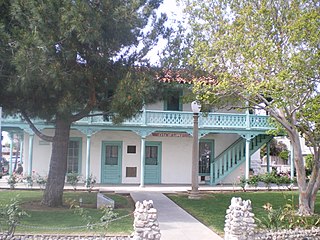
Lopez Adobe, located at 1100 Pico Street in San Fernando, California, is one of the two oldest private residences in the San Fernando Valley. Built in 1882 by early settlers of the San Fernando Valley a short distance from the San Fernando Mission, it was listed on the National Register of Historic Places in 1971.
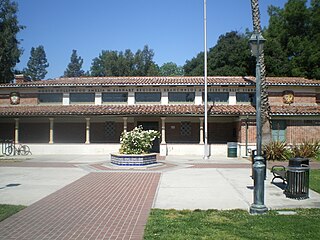
The North Hollywood Amelia Earhart Regional Library, which was formerly known as the North Hollywood Branch Library, is a branch library in the Los Angeles Public Library system, located in the North Hollywood area of Los Angeles, California. It was built in 1930 based on a Mediterranean Revival design by architects Weston & Weston.
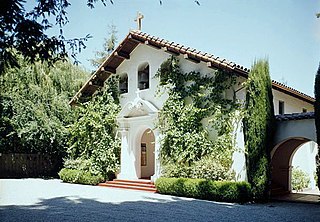
Our Lady of the Wayside Church is a modest church built in 1912 for the then-growing Catholic parish of Portola Valley by a combined effort of Jewish, Protestant and Catholic members of The Family, a San Francisco men's club that owns a nearby rural retreat.
The 1925 Santa Barbara earthquake hit the area of Santa Barbara, California on June 29, with a moment magnitude between 6.5 and 6.8 and a maximum Mercalli Intensity of IX (Violent). It resulted in 13 deaths and destroyed the historic center of the city, with damage estimated at $8 million.
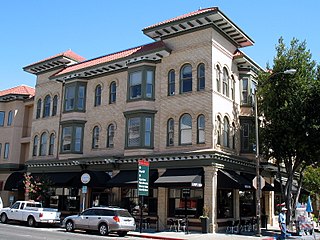
The Alexandria Hotel and Annex, also known as Plaza Hotel and Annex, is located at 840-844 Brown St. in Napa, California. Built in 1910, the hotel was a work of architect William H. Corlett. The hotel's design exemplifies the Mission Revival and Mediterranean Revival styles, which were both popular in California in the early 20th century. The design features three square towers on the street facing corners, overhanging eaves, and both slanted bay and rounded windows. The hotel's annex is older than the hotel and was redesigned to match the hotel's architecture when the hotel was built.

First Presbyterian Church is a historic church at 1333 3rd Street in Napa, California.

The Sam Kee Laundry Building, also known as the Pfeiffer Building, is a historic building located at 1245 Main St. in Napa, California. Built in 1875, the building is the oldest stone building and commercial building in Napa. The building has a generally simple design topped by a decorative Italianate cornice. As of 1880, the building was part of a brewery, which may have been the first brewery in Napa; it has since housed a boarding house, a saloon, and a laundry. The building currently houses the Vintner's Collective, a wine tasting bar.

The 2014 South Napa earthquake occurred in the North San Francisco Bay Area on August 24 at . At 6.0 on the moment magnitude scale and with a maximum Mercalli intensity of VIII (Severe), the event was the largest in the San Francisco Bay Area since the 1989 Loma Prieta earthquake. The epicenter of the earthquake was located to the south of Napa and to the northwest of American Canyon on the West Napa Fault.

The U.S. Post Office, also known as the Napa Franklin Station, served the 94559 zip code area of Napa, California. The post office was built in 1933 with funding from the Public Works Administration. Architect William H. Corlett designed the Art Deco building. The front facade of the building has three sections; the central section has six bays divided by piers with terra cotta capitals. A terra cotta cornice adorned with ram and cow heads tops the central section. The side sections, which contain the building's two entrances, feature panels with decorative eagle designs above the doorways and urn-shaped bronze light fixtures on either side. The post office's lobby features a painted bas-relief plastic ceiling, unusual in federally constructed post offices, and a terrazzo floor.
The 2000 Yountville earthquake occurred with a moment magnitude of 5 on a previously unmapped fault, about 3 miles (4.8 km) south southwest of Yountville, California in the Mayacamas Mountain Range under Mount Veeder and about 9 miles (14 km) south northwest of Napa, California. It occurred at 01:36 PDT on September 3.

The Napa County Courthouse Plaza is a complex in Napa, California, which consists of the Napa County Courthouse and the Hall of Records. The two buildings occupy an entire city block, which includes open areas and landscaping to create the site's plaza setting. The High Victorian Italianate courthouse was built in 1878 to replace the original 1856 courthouse. The courthouse continues to serve as the seat of Napa County government. The 1916 Hall of Records is a federally sponsored records building designed by William H. Corlett. The Renaissance Revival building represents an early use of reinforced concrete as a building material; the material became popular nationwide in the 1920s.

The Arkansas Valley National Bank, constructed in 1902, is a two-story, 30 feet x 90 feet sandstone structure located in Pawnee, Oklahoma. Constructed in a Late Victorian architectural style, it was Pawnee's original bank. When the building opened, the bank occupied the first floor, while a doctor, photographer, and local telephone office occupied the second floor. The bank closed around 1918, and the building has served as various storefronts since.



















